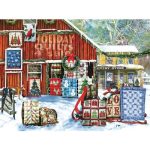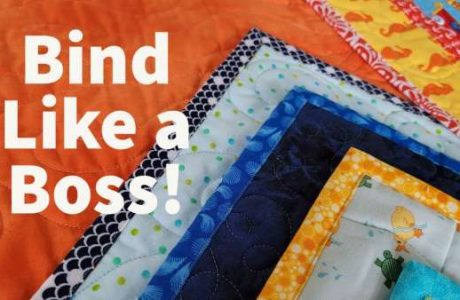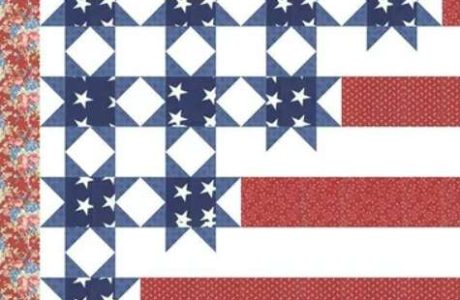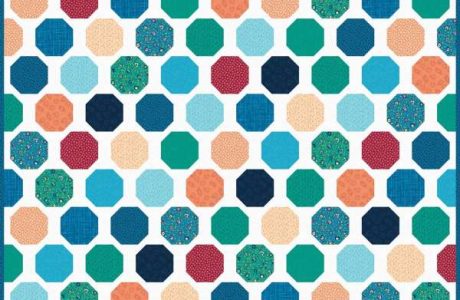I don’t usually write opinion pieces, but today is an exception. I just read a couple of recent posts by Sandi from Piecemeal Quilts and I cannot sit still. Her criticism of superstar bloggers who are modern in their approach to quilting (she mentioned Sew, Mama, Sew! in particular) got me to thinking about what it means to be a modern quilter. You might want to read what Sandi said in Part 1 and Part 2 and come back here. If nothing else, you should know the title she chose for these posts is The Dumbing Down of Quilting. Craft Gossip readers, I would love to hear what you have to say about the following in the form of a comment on this post:
How do modern quilters and guilds differ from traditional ones?
Should modern quilters be allowed their own language to express their experiences separate from traditional ideas of quilting?
Do you think modern quilters – who blog about their quilting and have learned much of their sewing skills from online tutorials – miss essential elements they could get from traditional sources such as traditional guilds or traditional publishers?
Does the modern approach to quilting inevitably lead to a lesser product than those made by traditional quilters?
The Modern Quilt Movement and its Offspring
Here’s some background if you are new to blogs and quilting. There is no disagreement that we are in the midst of a modern quilt movement; and it’s international thanks to online connectivity. The love child of this modern quilt movement – springing forth from the blogging community – is The Modern Quilt Guild. The first group met up in Los Angeles back in October 2009. Now there are chapters all over the world. Here’s the order. People met virtually first through blogging, then decided they must meet in person to learn and sew together.
Redundancy?
A traditional quilter might say this is an altogether unnecessary remake of regular guilds. They might add it’s not as if the massive count of quilt guilds in the US, Canada, Japan, Australia, New Zealand, France, Africa and United Kingdom, etc.,. have been running in place. Visit any one of them – with their guest speakers, libraries and retreats – and they guarantee you will learn the craft of quilting, including how to make an art quilt. So what is all the excitement over these newer modern guilds? I believe it’s mostly a mindset followed by a difference in focus. I’ve created a list of adjectives that, for me, describe the differences I see between trad and mod quilters.
The Modern (Mod) Quilter
1. Enjoys simplicity in piecing
2. Rule breaker
3. Focus is on the creative process and having fun with sewing buddies
4. Noncompetitive
5. Tends to be younger (under age 35) and is very comfortable with computers
6. Promotes inclusiveness among quilters
7. More likely to blog and learn quilting from online tutorials
The Traditional (Trad) Quilter
1. Enjoys complexity in piecing
2. Rule follower
3. Focus is on the end product and mastering “tried and true” techniques
4. Seeks out competition where there is a clear winner, especially for workmanship
5. Tends to be older and less computer savvy
6. Promotes exclusiveness among quilters
7. Less likely to blog and learn quilting from online tutorials
The Traditional Quilt Guild
I am not knocking traditional quilt guilds or those who take a solely traditional approach to quilting. I am sure there are many happy and contented members of trad quilt guilds who receive all the encouragement and support they need for their quilting journey. What I am expressing here is my own personal experience with them. Over the years the ones I’ve touched have offered me little in my growth as a quilter. I’ve waited many years for the likes of the modern quilt movement, as here I feel right at home.
When my child was young, I was a member of a decent trad guild, but I longed to be a part of another local trad guild, one that seemed friendlier. But for a working mother, meetings held only at 10 AM on a weekday are impossible to make. As far as I know, meetings of the Modern Quilt Guild accommodate working people. Back in the day, most trad guild members were over the age of 50. For a quilter like myself who started in her twenties, it was a lonely experience trying to find common ground with trad members. The mean age now of a trad quilt guild member is probably around 65. Another thing, most trad guild members are female and do not go out of their way to make men quilters feel welcome.
The Green Eyed Monster
Sandi, in her post The Dumbing Down of Quilting used the phrase “blog taught” as if the words were giving off a crap smell. In closing, I will share what I think I’ve gotten a whiff of from this quilter and more like her – jealousy. When superstar bloggers who quilt within the modern tradition get awesome book deals there’s bound to be some grumbling, especially among those who believe it’s happening to quilters who do not deserve it.









There is room for all quilters, traditional and non-traditional, to exist but there should be tolerance of “new” ways of doing things and new, fresh ideas…
The dumbing down of quilting is hilarious because if anything, these awesome quilt bloggers (myself being one of them) are thinking outside the box and actually making creative works of art without the ‘paint-by-number’ old way of quilting with the same pattern over and over…
Those crazy kids, how will they ever be controlled?!! 🙂
I had no idea this was an issue, but it seems bizarre to me. It’s better if we can encourage and help each other with our creative pursuits. If the modern quilters felt they were missing something, hopefully the traditional quilters would be approachable! Some people put others down to make themselves feel better and your conclusion about jealousy could be accurate!
We talked about this at length at a recent Modern Quilt Guild meeting. It seems silly, because for us it really boiled down to the thought that some people think that if you can’t “do it all” you shouldn’t bother doing it. I always thought that quilting (as well as all crafting) should be for everyone at every level (and with every interest), but there will always be someone that disagrees. Would you tell a writer that if they can’t write epic prose, they shouldn’t write at all?
Oh, I am so encouraged! I learned quilting from my mother, a traditionalist. When I was more interested in finishing a quilt than doing it “correctly” I felt guilt for choosing a simple pattern and breaking rules. (P.S. Mom has never finished a quilt because she insists on hand-quilting the top. What good is that?!) I’m so glad to hear about the modern quilting movement! Without them, quilting may have just died alltogether.
I guess I am of both mindsets. I am traditionally taught by my mother, but I have branched into the modern on my own and through my blog. Writing my blog has opened me up creatively in all realms of my crafts. Where before I would call myself a pattern follower, now I am a designer. I don’t look at other quilts anymore or books for inspiration unless there is a specific pattern I want to make. Now I look at the fabric and figure out what would be fun to make with it. I am also encouraged by the love and support you can find online from people who don’t even know you. It is an amazing feeling to have someone ask you for your pattern and not have anything negative to say about what you created. Sometimes all a creative person needs to let loose their creative energy is support, not to be told the things they did wrong or could have done better. Save that for the next project!
Thanks to each of you for your thoughtful comments so far. So well put.
Scarlett
There are no quilt or stitiching police.
Design is all about stretching boundries. As long as the project works for the person that made it then that is all that counts.
It would be boring if all quilts/dresses/cars looked the same. Expression is a good thing.
I’m not a quilter (yet) but this line “6. Promotes exclusiveness among quilters” made me decide I would not want to be a traditional quilter. Crafting should be for everyone. My mom taught me to cross stitch when I was kid and I picked up embroidery from doing a kit years ago but it was never something I did that often. It’s been the bloggers with their online patterns, tutorials and finished projects who have inspired me to stitch regularly and who have shown me how much fun it is.
I love your post and couldn’t have said it better myself. I work in the quilting industry and to me (and many others) quilting is an art!!! I learned from my mother that a quilt is either perfect or it’s done! It’s an expression of you and your love of fabrics arts! I love to do things “wrong” and break the rules! Thanks for the support!!!
I am not a quilter but my grandmother, great grandmother, and her mother all were. I value their beautiful traditional style quilts very highly. But if I were to quilt, it would be definitely be in the mod style! I am so drawn to the bright graphics, cheerful colors, and just the general whimsy of that type of quilting. I love Sew Mama Sew, and often look at her blog {and yours!} for inspiration in my papercrafts. I don’t think the advent of modern style quilting will harm traditional quilting. I think it’s just a natural progression of the art. And I am just glad that sewing and other needlearts are being continued in the modern age. Thanks for posting such an interesting topic!
I haven’t read the posts you’re responding to. I’m not sure I want to because it will probably make me mad! 🙂
I’m glad there is an availability of online tutorials. Without them, I probably wouldn’t be quilting. I learned to make my first quilt at a church meeting but now I’m on my own. I’m a homemaker. My husband is in IT, working for a consulting firm. His schedule is never the same and he always needs access to our (only) car. That leaves me at home the vast majority of the time with no ability to commit to regular meetings.
Do I mind? Occasionally, but not really. I love that there are quilting blogs, forums, and tutorials on YouTube. I am learning a TON from all of them. I would rather rely on technology as the method of transmitting information/instruction/motivation than not being able to quilt at all.
Cassandra
Of, and I’m 28, just learning how to quilt, and I LOVE my computer. 😉 So I guess that puts me in the Modern category!
Doesn’t this happen in all mediums of art where young ‘upstarts’ try new things, new ways, and rejuvenate the discipline to the chagrin of the ‘traditionalists?’ I’m thinking of all the movements in painting since I know so little about the art of quilting. 🙂 What an uninteresting world it would be if everyone saw things exactly the same and things didn’t evolve and change.
I personally love both the traditional and modern approach to quilting. I enjoy learning from others, whether it be a new way of doing things or time tested accuracy. I have only been quilting about 5 yrs. and I find myself constantly trying to challenge myself.It may be a fabric I normally would never consider using or an intricate paper pieced Mariners Compass, I don’t care, I want to do it all!!! I think the blog world is a fantastic tool for teaching an old craft a new way and just trying to have fun with it. If someone is put off by a different technique they’re not comfortable with, then move on and find another. Life is too short to sweat the small stuff! :0)
Scarlett, I’m so glad you brought this up. I’m awed when I visit a traditional quilt show by the precision of the quilts and the depth of skill of the quilters. And when I visit the blogs of moder quilters, I’m excited by the energy, color, and flexibility of design — and usually by the workmanship as well. The feeling I get from traditional quilters — on blogs, on TV, or in person — is that I need to pay a lot of dues and get it perfect. The feeling I get from modern quilters is, “Try this! It’s fun and rewarding.” Guess which attitude is more appealing to me. Modern quilters accept that there is much they can learn about process and technique from traditional quilters. I’m not sure that there’s reciprocal understanding. I’m nearly 60, but I definitely identify more closely with the youngsters who are changing quilting — as a domestic art and a true artform. The other stodgy old chicks need to wake up.
you sing it sistah! My experience and opinion mirror yours. Why oh why oh why do people have to tear each other down? Lifting each other up is way better even through all the differences. That’s just my take on it…but what do I know? I’m just a lowly modern quilter.
OK, I’m 55 years old and I’ve been quilting since the early 80s. I fit none of the traditional quilter traits and all of the modern quilter traits, and I know 6 or 7 women my age and older who are the same. I have never belonged to a quilt guild. I bought my first Mac in 1985. I have never made a traditional quilt. In fact, even when the only choice of quilt fabric was calico, calico or calico, I didn’t make traditional quilts. My early quilt teachers would walk past me as I worked, quietly shake their heads and move on. I am obsessed with quilt blogs and love the modern ones the most. I learned technique in quilt classrooms in the 80s, but I learned to break the rules on the quilt blogs. I will stare for hours at a simple but stunning coin quilt on a blog, but will walk past a king-sized Baltimore Album quilt that took the quiltmaker 10 years to make without a glance. I don’t dislike traditional quilts; they’re just not my thing. There’s room for all kinds of quilters and all styles of quilts. Let’s stop the stereotyping and start to enjoy each other’s expression of their art.
I had no idea that such debate was going on. But, to me, it seems a non productive one! I don’t like labels either, the thought of put people in groups and label them troubles me. The way I see it, traditional quilters brought the knowledge to our days but is modern quilters that are spreadig the word. I’m from Portugal, until recently quilting was not popular here (and I’m not sure that it is now), and if I learn anything it was through internet. I made my first one (that I discover through this post, a traditional quilter would refuse to name it quilt) with lot of mistakes but I’m proud of it and of myself. I think all crafts (and crafters) benefit with the internet, we get to exchange knowledge and inspiration and maybe we save some crafts of extinction in the way.
Let’s face it, until recently crafts were not an issue and were not cool and lot of knowledge is probably lost because the last crafters die without be able to pass their knowledge to the next generation. With that in mind, I think it would be a lot more productive if everyone start to share and learn and stop labels fights!
I’m a blog-taught quilter. I would have loved to have been taught by traditional quilters, but it has never been practical. I think anyone who wants to learn this awesome craft should be encouraged. Spread the fun!
I have seen the rivalry first hand at our own MQG meetings.
There are a number of traditionalists who have joined and are valuable contributing members. They help those of us who are blog taught learn the value of some of the more intricate quilt techniques and how to use them and are happy when they inspire innovation.
But then there are also those traditionalists who come to meetings in order to criticize and devalue the movement. They mumble nasty comments to each other about the quality of work and how “Modern” is not the correct word to use. They rail on and on about how we are just blatantly appropriating the ideas of Gee’s Bend and claiming them as our own and on and on.
I just don’t understand that mindset. Why the rivalry? I guess it is why I would never have been drawn to traditional quilting. The competitive side of it would chase me away even if I did love the quilts.
I am over 35 and I am a Modern Quilter mostly because I love modern fabrics. The colors and designs of modern quilts appeals to me. They fit with my decor.
I am blog taught not only because I love the quilts, but also because the internet is available at 11 at night when I am able to quilt. (another reason for no complicated piecing!)
As a self-taught (books, blogs, patterns) sewist and quilter, I see her point and I’m enraged by her point.
I understand her criticism of labeling something as “intermediate” that would be a “beginner” skill in a trad quilt setting. But, I think she needs to remember that many who consider themselves mod quilters didn’t have the foundational learning of basic traditional skills.
(I started to type a much longer response to this and decided that I’m going to draft a blog post of my own!)
I hear you Milica. Your experience is exactly what I’m talking about. Here’s one of mine. As the acting President, I was leading the business portion of one of our monthly meetings of the Modern Quilt Guild at the Fort before the sewing started. Two members of the local quilt guild (Belle Point) dropped in. As I gave an overview of our rules, one of the visitors interrupted me asking what exactly were the plans for our dues -as if somehow we were going to misuse them. (by the way, the founding members have spent lots of their own money to get things started, and gladly). Then as I talked about our MQG at The Fort Facebook page, she barged in again and said, “I’m not about to get on Facebook for anything.” The situation at the Bell Pointe guild is that it’s like being back in High School. A member of the Modern Quilt Guild said she went to a meeting at Belle Pointe as a first time visitor, and was told she couldn’t sit at the table she approached, it belonged to someone else. Another time, she said members had brought in blocks to exchange and a Belle Pointer was picking one apart (they were on a board for all to see), saying she had not matched her points. No name was mentioned, but how humiliating that must have been for that person – who was likely proud of her work.
Though I made a generalization in my article about age, I am certain there are many 35+ (myself included) who share the modern vibe. Ultimately, it is not about age, it’s about attitude.
Please don’t make the assumption that all (or even most) traditional quilters have negative opinions of “modern” quilters. I have been teaching quiltmaking for nearly twenty years, and I do prefer that style, as a matter of personal choice, but I delight in seeing fresh ideas and the happiness of people who enjoy creating. As I read your article, though, I thought of a couple reasons why this gulf might exist between older quilters and younger ones. It’s not an excuse for rude behavior or criticism, of course.
1. “Modern” quilters can be modern or art quilters because of the easy access to a wide range of calico fabrics. When I started quilting 25 years ago, our choices were slim. We could be creative within the choices we had, but it was nothing like we have now. Everyone makes quilting fabric!
2. “Modern” quilters have more time to do creative projects because they are QUICK! Sewing quilts used to take so long that it felt almost like a “commitment.” Now, we can whip one up in no time at all. That’s mostly a result of the rotary cutter and Eleanor Burns. 😉 I got my first rotary cutter 25 years ago, when we lived in Germany. (I still have it, but I have graduated to a 45 mm for daily use.) We didn’t have gridded mats or rulers. What a mess. So most of the quilts we made had to be handcut and sewn piece-by-piece. Hand basted, hand quilted. Quilting was a relaxing, delightful thing to do. We found pleasure in it, but very seldom did it evoke the word “fun.” It was a long process — a big time commitment. We loved it, but it felt serious to us.
Eleanor Burns – who most of you probably think of as an old lady! – was the woman who revolutionized quiltmaking. Her Quilt-in-a-Day books changed everything. I took the Log Cabin quilt in a day class in 1989. I still had my 28 mm cutter and the mat with no grid, and that was frustrating, so I followed her instructions and TORE my fabric into strips. It was messy, but it was the beginning of a whole new way of quiltmaking. At that time, we were the “modern” quiltmakers! LOL
Back in 1988, she was still teaching a pillowcase turn and tied technique, and that was fine for this kind of speedy project. When we had to make the quilt top one piece at a time, we weren’t about to tie them! Every quilt was expected to be an heirloom.
3. That brings me to a third point: hand quilting vs. machine quilting. At one time, machine quilting was considered quite inferior. And honestly, it was. It didn’t look anything like what you see today. In order to avoid that machine-quilted look, quilters used invisible nylon thread. The poor quality of that thread not only damaged the softer cotton fibers of the calico, it also reflected light.
Machine Quilting got better. I was living up north of Spokane in 1992 when Debbie Mumm started publishing quiltmaking books and patterns that featured machine quilting. She made it look good! Looking good made it an acceptable way to finish those quilt tops into which we had invested so much piecing time!
That technique flourished. Within another ten years, it was becoming popular even for bed-sized quilts. Soon, ladies were buying long-arm machines and there was a new cottage industry born.
4. At this point, I think we started seeing some resentment brewing in competitive quilters, and I think it could have been avoided. County and state fairs (before we had many big specialized quilt competitions) didn’t catch on to the changes in quiltmaking. Women whose quilts were the result of years of handwork were judged in the same categories as women who machine quilted at home or even those who were having their quilt tops sent out to be professionally machine quilted. They should have started separating those categories then, validating the exciting new techniques and appreciating the value of the handwork, instead of trying to make them compete with each other.
5. Back to the concept of “modern”…. I LOVE the bright, trendy projects I see now, especially with a couple granddaughters to sew for. If I still had to do those projects the “old-fashioned” way, however, I would probably not do them. When we invest hundreds of hours in a project, we want it to be classic. What was modern in 1985 looks dated now. Not old enough to be antique or vintage — just dated. What is modern today is going to have the same issue in another 20 years. Because I can make them in a few days, I am happy and willing to work with the more “modern” fabrics and projects. I hope that makes some sense.
I work with bridal quilts, and it’s something I stress with the bride. She may want to decorate her bedroom in kiwi and black now, but this special quilt is supposed to become a family heirloom — one she will be glad to use for the rest of her life and hand down to her children. So we find a compromise – something that isn’t old-fashioned in design (prairie calico prints – ugh), but something that will endure.
I still hand quilt, but I save it for very special projects. Nearly everything else is machine quilted – and that quilting is part of the design. Virtually everything (even parts of Double Wedding Rings) is rotary cut.
I was self-taught until 1988, learning from magazines. Then I took classes, and then I went to Quilt Markets to learn to be a better teacher and designer. Now I learn a lot online! I am quite computer literate. I believe that 95% of “traditional” quilters enjoy the modern techniques and the way they have changed quiltmaking. We have so many opportunities now! We can make a dozen or more quilts in a year instead of one.
What you are seeing is the 5% of ladies who just complain in general. I am sorry for their rudeness. I hope my VERY LONG post here will help you understand whence their attitudes spring. Not acceptable attitude, but I can see how they got that way.
It reminds me of photography. People used to have to invest a lot of time and money into photography. You got one shot at something, had it developed and hoped it turned out. You learned to play with F-stops and lighting, and it became a skilled art. Point-and-shoot 110 cameras came out, but the efforts were still hit-and-miss. An amateur might luck out and get good shots, or everything might end up overexposed. Then came digital photography. Everybody and their dog had a camera. You could take a hundred pictures of Baby Susie, view them immediately, delete the ones that didn’t turn out and edit the rest, ending up with truly gorgeous portraits. Suddenly, the industry is flooded with wedding and portrait photographers abound. 95% of the old-fashioned photographers gladly embraced that as progress, but there was surely still a little resentment that what used to take them SO much skill and time was suddenly a very common thing.
Thanks for letting me “blog on your blog.” And don’t assume that traditional quilters all behave so badly or even think badly of you. The world has changed more dramatically in the last 25 years than it has in hundreds of years before. Some of us are just a little slow at keeping up!
Have fun with quiltmaking! If it’s not fun, you might as well go buy your quilts at JC Penney. They’re cheaper over there. 😉
Thank you Cathe for providing some much needed historical perspective on this hot topic. I guess we should all just “Quilt and let Quilt”.
Stacie asked, “Doesn’t this happen in all mediums of art where young ‘upstarts’ try new things, new ways, and rejuvenate the discipline to the chagrin of the ‘traditionalists?’” In 1983, I earned my double major in commercial and fine art, and have worked in graphic design since then. (I also love hand crafts, BTW.) Here’s my generalized take on creative things: Stacie, you’re so right – it happens all the time!
For example, Impressionist artists were completely rejected at first. Now it’s hard to imagine a museum without them. It used to be debated if it was really “art” when you didn’t draw/paint from a model. Now the question is whether it’s “art” if you use a computer.
Whatever! While I think my days with a t-square, x-acto knife and drawing table gave me a fuller understanding about the printing process, designers who don’t know a world without a computer have created some amazing things. Bottom line: my caveat for modern quilters is to follow your muse, but don’t dismiss traditional methods entirely.
If only quilting methods were the most important issue of today!
I have stitched one way or another (quilting, knitting, crochet, embroidery, etc) for almost my whole life … nearly half a century. And it seems in that time every new technique (ie machine quilting vs hand quilting) comes in for its fair share of criticism. Usually unfairly. If it wasn’t for folks stretching the boundaries on all the forms of creativity, nothing new would happen – all these expressions of beauty from the “modernists” would simply not exist.
So – that’s very healthy.
Learning on-line is pretty much the norm for anyone who is computer savvy (even octagenarians)…you can get a university degree via distance learning, learn embroidery stitches, learn how to change the oil on your car…etc, etc, etc. So learning skills & techniques online is not unique to quilting or other needle arts.
And sharing online successes and failures is also a good thing.
There is a “but” though – all forms of needle work (quilting in particular) have a social aspect to them. The getting together of persons with similar interests is a very special experience – if you aren’t doing this as a part of your creative life as well the work you do in solitude you are missing out on a terrific influence…
The quilt guild in my town has well over 100 members. We do everything from hand piecing and quilting to art quilts (which are quilts really only by virtue of having three layers being held together with stitching). While the larger guild is (in my opinion), quite conservative overall we have handled the “issue” of modernity (or different techniques) by having room for mini-groups. They are stand alone smaller groups of like minded individuals who flock together. At show and share all the groups show their completed work – and we all appreciate it.
So – as said above “Quilt and let Quilt”. The modern techniques (those that are good enough) will stand the test of time and become the tried and true of the future, enriching all our creativities.
Adrienne
It’s a little sad that there are some people who are so critical of what is supposed to be a fun hobby. There are bigger fish to fry. Quilt on!
P. S. I think I ran into you at Joann looking for the DS fabric! How fun!
Hi Delia! Yes that was me this morning cruising for some Denyse Schmidt yardage! Did you end up buying some from the stockroom? What a scream – that’s the most fun I’ve had at Joann Fabric like ever! 🙂 So glad to meet a like-minded quilter. Dito…Quilt on sista.
Well put Denise. I just rescued your comment from my Spam folder. Wonder why WordPress thought it was spam? – Scarlett
Smells like jealousy and resentment. I am new to quilting and would not have started if not for all the fantastic blogs and tutorials furnished by the modern “young’uns”, so inspiring, creative, beautiful, and my cup of tea. I have learned so much from sewmamasew, et al and am so grateful to all who share their knowledge and hard work. Keep it up, please. btw, I am a 59 year old grandmother of 3…
I remember the women gathering at my great grandmother’s house for an afternoon of quilting using a frame that lowered from the ceiling using a pulley system. But what I remember more than the circumstances was the good natured ribbing they would give each other over uneven stitches or the occasional puckered seam. At the end of the day everybody hugged and seemed sad to leave.
My point is that it’s ok to (kindly) critique each other but it’s not ok to be mean and not care.
Wow… All I can think is that if someone has the “need” to disparage someone else’s work, that person is a very insecure individual.
My advice to her is:
Play nice or pick up your toys and go home.
Oh yes, thank you for saying this! I truly believe that we are ALL creating ART, whether traditional quilting or in art quilts to hang on the wall. What I do not understand is, why traditional quilters feel threatened by the emergence of what has become a many billion dollar industry of THEIR craft! They should be thrilled! Something that started with the necessity to keep our ancestors warm, and something they passed down to generations, has been kept still traditional and has also grown to include men and women from around the world. Only because of our ability to communicate as we can these days can we see through the eyes of others to the point that we stand in front of a beautiful quilt with our mouths open at the amazing amount of work involved to make the piece, or do we look in awe with tears in our eyes when we read or hear the inspiration for a piece. Whether we follow patterns or not we are all putting our hearts into each quilt!
Thank you so much for this eye opening article. I am an art quilter and have been part of a traditional guild for 2 years now and have been very frustrated. Now my eyes have been opened, it was my own naive outlook. I am a friendly person and accepting of peoples talents and have turned myself inside out to try and be accepted. I was unaware it was their dogmatic approach to quilting that was counting me out. I never gave it a thought that they did not view my work as quilting. What a shame. Can we not learn from each other??
I really like what Cathe said. I am 61 years old, started quilting in 1998, never joined a guild. I learned from TV, books,classes, and magazines. I really appreciated the skill that was involved in making beautiful quilts. Look at how respected and admired the Japanese quilts of today are. But I also am so inspired by some of the modern quilts made today. I read all of Sandi’s posts and agree with most of what she said. She wasn’t being malicious, although mentioning SewMamaSew wasn’t nice. She was mostly wishing that people would try to stretch their abilities and not keep making the same simple quilts over and over. I do think that a lot of good information and insight can be gained by new quilters from the years of acquired knowledge of more traditional quilters. And the trad. ones can get a breath of fresh air from the boldness of the art quilters. And I don’t think it is jealousy. It’s more like feeling that skills are being tossed aside, as so many young people treat older folks.
As someone with no artistic ability, I almost feel ashamed about using someone else’s patterns when young art quilters can take some fabric and whip up something new and original. I guess I don’t fit in either camp.
I own a modern sewing shop, The Top Stitch. Last summer we started the Spokane chapter of The Modern Quilt Guild. Our group is made up of all ages. Those that are experienced quilters, are interested in mentoring new quilters, and the new quilters, are interested in showing their uses of the modern fabrics (designers like Amy Butler, Anna Maria Horner, Joel Dewberry and more). This summer we are meeting virtually, by blog and facebook (spokanemodernquiltguild.wordpress.com and yes, for the experienced quilters this is a new and some mentoring is necessary.
Occasionally we have quilters come into the shop and are overwhelmed with what to do with these fabrics, believing the larger prints cannot be cut up for traditional piecing.
I suppose it is difficult to get out of comfort zones. Change is usually difficult, but I would like to encourage bloggers like Sandi to take a step outside their comfort zone and begin a new experience before assuming quilting has been “dumb down”. Perhaps she would be shocked to see how many experienced, traditional quilters are coming into my shop, purchasing the modern fabrics and creating stunning pieces!
I think there’s actually less of a distinction between ‘modern’ quilters and ‘traditional’ quilters than the blog-o-sphere would like to admit.
I would disagree with your conception of modern quilters as being ‘friendlier’ or ‘more open’ – I think all groups can form cliques, whether the members are retired grandmothers or young professionals. The ‘traditional’ guild meetings that I’ve gone to were full of incredibly open and friendly people.
I’ve also noticed every bit as much ‘competition’ among modern quilters as traditional quilters. And I’ve seen modern quilts in quilt shows too. So the traditional quilters do not have a monopoly on ‘competitiveness’ by any means.
In fact there seems to be quite a lot of bragging and boasting and self-promoting among the modern quilt blogs. There is of course a layer of “anyone can do this” and “I support all types of quilts”, but the undercurrent of “buy my book and you can make fabulous quilts like me” is pretty strong too.
As for ‘rule breaking’, it’s hard to argue that modern quilters are ‘breaking the rules’ when hundreds and thousands of people buy the super-star quilter books and just go on to produce copies of those same quilts. There’s nothing wrong with this. It’s just no more ‘rule breaking’ than following a traditional pattern. In both ‘traditional’ and ‘modern’ quilting, you’ll find true pioneers in each group, and you’ll find pattern followers in each group.
All of the things touted by ‘modern’ quilters have been done for ages – the ideas of reworking old patterns in new ways, coming up with new patterns to reflect their own personal experiences, changing techniques to match the changing technologies, following fads with regards to particular fabrics, etc etc. Even the blogging isn’t unique to ‘modern’ quilters. When I first started quilting in the early 2000s there were already blogging-rings to connect existing traditional quilters with each other.
Frankly, I think the only true difference between ‘modern’ quilters and ‘traditional’ quilters is a type of ‘branding’ that seems prevalent in the modern-quilt blog scene.
While I support the various directions that quilting is going in, it does bother me that people feel the need to make such a distinction. I think both traditional and modern quilters have a lot to learn from each other, and would probably benefit from working together in the same guilds, rather than focusing on artificial distinctions.
Rebel,
Thank you for sharing your thoughts. As time goes by, I have to say I am much closer to thinking as you do about this subject. Even Denyse Schmidt (known as a Modern Quilter) talks about her dislike of making a distinction between “modern” and “traditional” quilters.
Scarlett